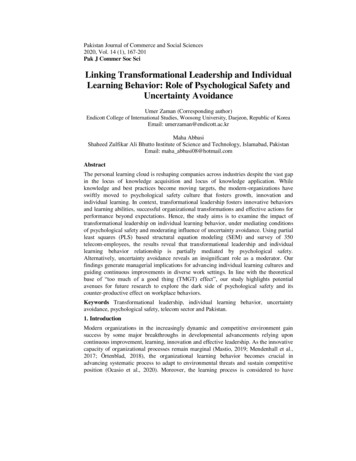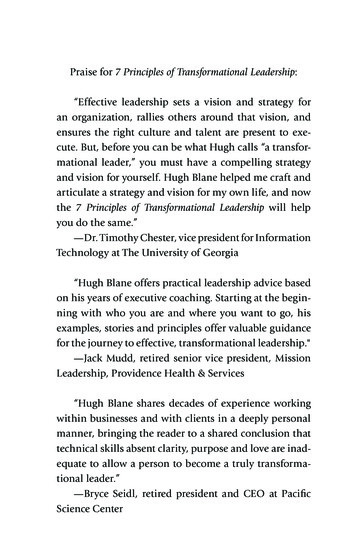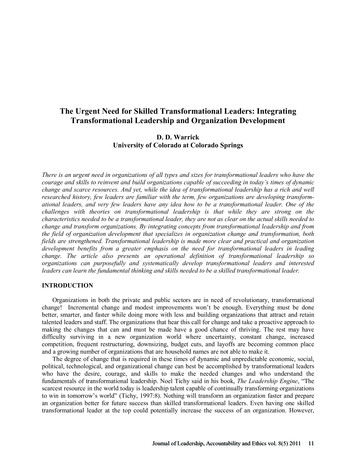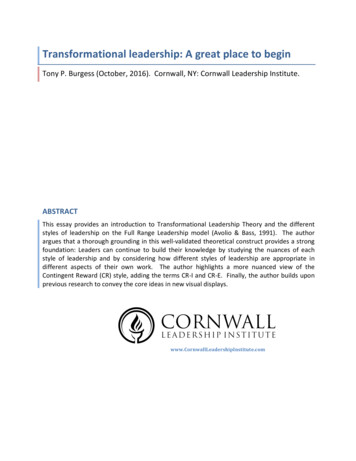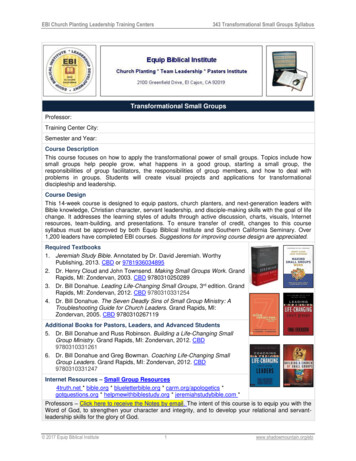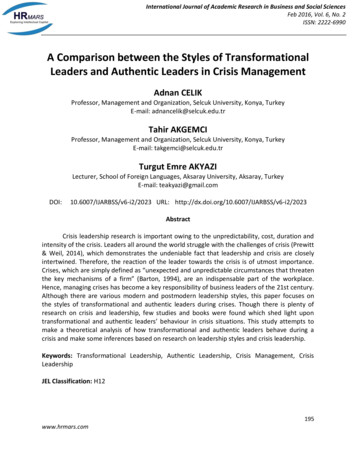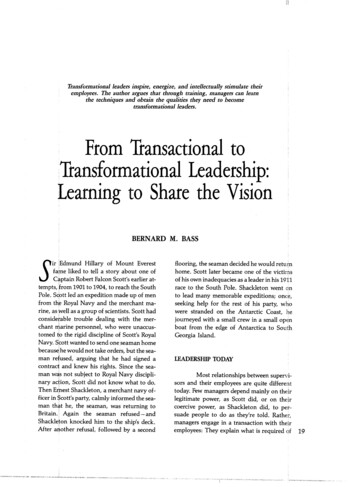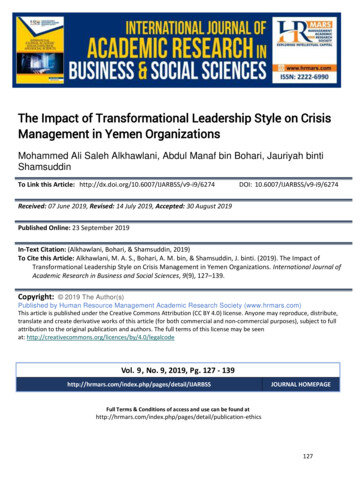
Transcription
International Journal of Academic Research in Business and Social SciencesVol. 9 , No. 9, September, 2019, E-ISSN: 2 2 2 2 -6990 2019 HRMARSThe Impact of Transformational Leadership Style on CrisisManagement in Yemen OrganizationsMohammed Ali Saleh Alkhawlani, Abdul Manaf bin Bohari, Jauriyah bintiShamsuddinTo Link this Article: http://dx.doi.org/10.6007/IJARBSS/v9-i9/6274DOI: 10.6007/IJARBSS/v9-i9/6274Received: 07 June 2019, Revised: 14 July 2019, Accepted: 30 August 2019Published Online: 23 September 2019In-Text Citation: (Alkhawlani, Bohari, & Shamsuddin, 2019)To Cite this Article: Alkhawlani, M. A. S., Bohari, A. M. bin, & Shamsuddin, J. binti. (2019). The Impact ofTransformational Leadership Style on Crisis Management in Yemen Organizations. International Journal ofAcademic Research in Business and Social Sciences, 9(9), 127–139.Copyright: 2019 The Author(s)Published by Human Resource Management Academic Research Society (www.hrmars.com)This article is published under the Creative Commons Attribution (CC BY 4.0) license. Anyone may reproduce, distribute,translate and create derivative works of this article (for both commercial and non-commercial purposes), subject to fullattribution to the original publication and authors. The full terms of this license may be seenat: deVol. 9, No. 9, 2019, Pg. 127 - SJOURNAL HOMEPAGEFull Terms & Conditions of access and use can be found tion-ethics127
International Journal of Academic Research in Business and Social SciencesVol. 9 , No. 9, September, 2019, E-ISSN: 2 2 2 2 -6990 2019 HRMARSThe Impact of Transformational Leadership Styleon Crisis Management in Yemen OrganizationsMohammed Ali Saleh Alkhawlani, Prof. Abdul Manaf bin Bohari,Dr. Jauriyah binti ShamsuddinSenior Lecturer, School of Business Management, University Utara MalaysiaEmail: Alkhowlani2000@yahoo.com, manafdr@uum.edu.my, jauriyah@uum.edu.myAbstractThis study aims to examine the impact of transformational leadership style on crisismanagement and to examine the moderating effect of manager’s crisis experience on therelationship between transformational leadership style and crisis management in Yemenorganizations. Data was collected from 239 large private organizations in Yemen, through theself-administered questionnaire procedure. Partial Least Squares-Structural EquationModelling (PLS-SEM) was employed in the data analysis. The result indicates thattransformational leadership style has a significant positive influence on crisis management.The result also reveals that the manager’s crisis experience moderate the relationshipbetween the transformational leadership style and crisis management. In practical terms, theresults of the current study offer several implications for managers regarding the importancerole of the factors enhancing crisis management in Yemen organizations. Moreover, leaderwith a prior crisis experience is more capable to handle the crisis situation. The limitation ofthe current study and the recommendation for the future study are highlighted.Keywords: Crisis Management, Manager’s Crisis Experience, Transformational leadershipIntroductionCrisis is an unexpected, dramatic, and unprecedented event that forces an organization intochaos and may destroy the organization (Prewitt, Weil, & McClure, 2011). However, the 2011crisis in Yemen adversely impacted the employment, large, small and medium-sizedenterprises (SMEs), product and food prices and basic services in public and privateorganizations in Yemen. It is estimated that 15 percent of all private-sector workers and 30 40 percent of factory workers lost their jobs, while the salary of most employees was reducedby around 20 percent and unpaid leave was extended by up to six months (UNDP, 2013). Insuch circumstance, crisis management is essential to minimize economic losses and to ensurecompanies’ survival (Sfakianaki, Iliadis, & Zafeiris, 2015). Effective crisis management canminimize the impact of the crisis on organizations (Spillan, Parnell, & de Mayolo, 2011). Areview of the previous literature has revealed that in times of crisis, effective leaders havetaken crucial actions to reduce the concerns of the organization members and inform them128
International Journal of Academic Research in Business and Social SciencesVol. 9 , No. 9, September, 2019, E-ISSN: 2 2 2 2 -6990 2019 HRMARShow the crisis could affect them (Yukl, 2010). DuBrin (2013) stressed that to mitigate theconsequences of the crisis, transformational leadership is the best choice, and it worksperfectly in the immediate and post-crisis stages. Likewise, in a crisis situation,transformational leadership has been identified by researchers as the most comprehensiveand effective approach. Transformational leadership style has been extensively and intenselystudied, whereas transformational leadership style during the crisis still needs to be explored(Alkhawlani, Bin Bohari, Haderi, Ahmed, & Rahim, 2016; Alkhawlani, Bin Bohari,&Shamsuddin, 2019). Research on the importance of the transformational leadership during acrisis situation, are still scant, according to Pillai (2013), who advocated that there is still muchto learn about the effectiveness of transformational leadership across cultures during a crisissituation. However, crisis experience enhances the crisis leader’s sense-making abilities of thesituation, and their learned lessons contribute to a more confident. Thus, manager’s priorexperience in a crisis situation assit to understand approach of crisis readiness (Cronin, 2015).Many studies mentioned that leader experience of a crisis makes the organization to be betterprepared for future crises (Kovoor-Misara, 1996; Rousaki and Alcott, 2006).According to the discussion above, there is a lack of empirical studies that have investigatedthe important factors affect crisis management, especially during crisis confrontation, such asleadership style and the role of manager’s crisis experience. The gap is excited and justifiesthe need for empirical studies to be conducted while the Yemen organizations areexperienced the crisis. Therefore, this study aimed to examine the impact of transformationalleadership style on crisis management and to examine the moderating effect of manager’scrisis experience on the relationship between transformational leadership style and crisismanagement in Yemen organizations.Literature ReviewTransformational leadershipIt is a fact that crisis and leadership are inextricably related. Every follower looks up to theleaders during a crisis situation and expects them to do something (Zhang, Jia, & Gu, 2012).In a crisis situation, transformational leadership can lead the organization towards a betterfuture by encouraging the organization's members to express their ideas on how to cope withthe crisis and work collaboratively, to either manage or avoid crisis situations (Harwati, 2013).Transformational leadership can be defined according to Bass and Avolio (1994) as “a set ofinterrelated behaviors, including idealized influence, inspirational motivation, intellectualstimulation and individual consideration” (Dust, Resick, and Mawritz, 2014). The model oftransformational leadership was developed by Bass and Avolio (1994), including four primaryfactors: “idealized influence, individualized consideration, intellectual stimulation andinspirational motivation”. Transformational leadership components are explained in detailsas follow. Idealized influence: Instilling pride and respect for the leader; shares a vision andsense of mission. Representation of a trustworthy leader and acts as a role model forthe follower. Individualized consideration: Leaders treat each subordinate differently according tohis or her particular needs and capabilities.129
International Journal of Academic Research in Business and Social SciencesVol. 9 , No. 9, September, 2019, E-ISSN: 2 2 2 2 -6990 2019 HRMARS Intellectual stimulation: Leaders “stimulate followers’ efforts to be innovative andcreative by questioning assumptions, reframing problems, and approaching oldsituations in new ways”.Inspirational motivation: Leaders “behave in ways that motivate and inspire thosearound them by providing meaning and challenge to their followers’ work”.Source: Rowold and Heinitz (2007)Transformational leadership has been studied extensively; several studies have reported thatthe transformational leadership style has been associated with numerous variables, such asorganizational learning (Mirkamali, Thani, & Alami, 2011); employee effectiveness(Srithongrung, 2011); creative flexibility (Sharma, Nagar, & Pathak, 2012); communicationcompetency (Çetin, Karabay, & Efe, 2012); leadership effectiveness (Zhang et al., 2012); andemployees’ job satisfaction (Munir, Rahman, Malik, & Ma’amor, 2012). Only limited empiricalstudies have focused on the relationship between transformational leadership and crisismanagement, such as Hasan and Rjoub (2017), who examined the association betweenleadership styles and crisis management in the Ministry of Planning in Erbil, Iraq; the findingsreveal that transformational leaders can predict crisis management. Similarly, Sarkar and Ray(2015) examined the role of transformational leadership style in crisis management, targetingthe correctional officers of the West Bengal organizations and found that transformationalleadership style has a significant association with crisis management. In addition, previousresearch has mentioned the requirement for more research on the association betweentransformational leadership and crisis management ( Alkhawlani, et al., 2019; Cho & Tseng,2009; Pillai, 2013; Zhang et al., 2012). Thus, responding to the recommendation of theprevious research, this study hypothesized that:H1: There is a positive relationship between transformational leadership and crisismanagement.Manager’s Crisis ExperienceCrisis experience can be defined as knowledge and the skills that individual or organizationgained, in particular, situation, specifically, during crisis situation (Alkhawlani, et al., 2019). Inliterature, only very few studies regarding crisis experience such as Reynolds (2009) found apositive relationship between crisis experience and effective communication but norelationship between crisis experience and transformational leader behavior. In addition,Carmeli and Schaubroeck (2008) assumed that crisis experience would be positivelyassociated with crisis-preparedness, but the results of the study didn’t support thehypothesis. A further study conducted by Guth (1995) argued that there is a relationshipbetween organizational size and crisis experience. Cronin and Parry (2014) explained thatleadership had prior crisis experience is more confidence, and it being reflective in theirdecision making. Moreover, Rousaki and Alcott (2006) argued that prior experience of thecrisis is associated with increasing crisis readiness. In the same line, Schwarz and Pforr (2011)confirmed the association between crisis experience and crisis preparedness. As discussedabove all studies mentioned the important role of crisis experience in enhancing crisismanagement, but no study examines categorical variable manager’s crisis experience asmoderator effect in relationship between transformational leadership, and crisismanagement. Therefore, this study hypothesized that:130
International Journal of Academic Research in Business and Social SciencesVol. 9 , No. 9, September, 2019, E-ISSN: 2 2 2 2 -6990 2019 HRMARSH2: There is a positive relationship between manager’s crisis experience and crisismanagement.H3: Manager’s crisis experience moderates the relationship between transformationalleadership style and crisis management.Crisis managementCrisis has a harmful result on the organization stability that leads to the serious question,whether or not organizations would be able to continue after crisis situation (Seeger, Ulmer,Novak, & Sellnow, 2005). Therefore, crisis management has been established to efficientlyand effectively prevent and reduce the negative consequences of the crisis situation. Crisismanagement has been extensively studied during the past three decades and defined bymany different authors. There is no single definition that is commonly agreed upon the termof crisis management (Coombs, 2007). Santana (2004) defined crisis-management as, “anongoing integrated and comprehensive effort that organizations effectively put into place inan attempt to first and foremost understand and prevent crisis and to effectively managethose that occur, taking into account in each and every step of their planning and trainingactivities the interest of their stakeholders. Numerous models of crisis management havebeen developed by researchers, such as Coombs (2007); Cronstedt (2002); Fink (1986); Jaques(2007); Loosemore and Teo (2000); Myers (1993); Smith (1990). Mitroff, Pauchant, andShrivastava (1988); Mitroff, Shrivastava, and Udwadia (1987) developed a crisis managementmodel, which includes five mechanisms that need to be in place: “signal detection;prevention/preparation; damage containment (limitation); recovery and learning”. Thismodel represents the holistic crisis life cycle that stimulates action throughout the crisis, andnot only during the pre-crisis or post-crisis period, like other models. However, previousstudies have identified the factors influencing crisis management, such as long-term strategy,internal and external strategic orientation and crisis readiness (Mostafa, Sheaff, Morris, andIngham (2004); organization size, job level crisis experience and crisis readiness (Rousaki andAlcott (2006); management experience and crisis readiness (Parnell, Koseoglu, and Spillan(2010); organizational type, organization size, organization age and crisis preparedness(Ritchie, Bentley, Koruth, and Wang (2011); and strategy innovation, strategy on low costsand crisis readiness (Spillan et al., 2011). Accordingly, no study accommodatestransformational leadership, manager’s crisis experience and crisis-management stages.Therefore, this study examined the effect of those factors on crisis management.MethodologyThe present paper used the quantitative method and was conducted in Yemen. The targetpopulation is large private organizations that registered under the Ministry of Industry andTrade in Yemen. The top management is representative of the population of the currentstudy. These respondents met the requirements of the study by providing valid and accurateviews of their organization. The Krejcie and Morgan (1970) table was used for determiningthe sample size of the present study, which is 281 large private organizations in Yemen. Simplerandom sampling was used to select the respondents. Out of the 281, only 239 questionnaireswere returned. The questionnaire was adapted from previous studies (Alkhawlani, et al.,2016; Sadeghi and Pihie, 2012). The instrument had been validated by earlier researchers anddeemed to be ideal for the current study. A five-point Likert scale was used to measure thetwo variables, namely transformational leadership and crisis management. The manager’s131
International Journal of Academic Research in Business and Social SciencesVol. 9 , No. 9, September, 2019, E-ISSN: 2 2 2 2 -6990 2019 HRMARScrisis experience was examined as a categorical variable. A cover letter attached to eachquestionnaire explained the objective of the survey and assured the respondents of theconfidentiality of their responses.ResultsThe PLS-SEM (Partial Least Squares-Structural Equation Modeling) approach was employed indata analysis in this study. Hair, Hult, Ringle, and Sarstedt (2017) recommended that PLSanalysis involves two stages for reporting the results: the assessment of the measurementmodel in the first stage; and the assessment of the structural model in the second stage.Assessment of Measurement ModelAccording to Hair et al. (2017), the key criteria used to evaluate the measurement model areinternal consistency reliability, convergent and discriminant validity. To evaluate theconvergent validity of reflective constructs, researchers consider the outer loadings of theindicators and the average variance extracted (AVE). The recommended values for the outerloadings, according to Hair, Black, Babin, Anderson, and Tatham (2006), are 0.5, andpreferably 0.70., the average variance extracted (AVE) should be 0.5, and the compositereliability (CR) should be 0.7. The researcher conceptualized transformational leadershipstyle and crisis management as second-order constructs, which is consistent with theoreticalconcept and supported by Hair, Hult, Ringle, and Sarstedt (2014), who recommended utilizingsecond-order construct to reduce the number of relationships in the model. Thus, the methodsuggested according to Hair et al. (2017) in PLS-SEM is the repeated indicator approach forthe second-order construct. Table 4.1 shows the results of convergent validity which exceedsthe recommended values and representative sufficient convergent validity.132
International Journal of Academic Research in Business and Social SciencesVol. 9 , No. 9, September, 2019, E-ISSN: 2 2 2 2 -6990 2019 HRMARSTable 4.1Convergent Validity First & second OrderConstructsSecond Order ConstructFirst .9230.7530.9550.7630.9510.8050.9430.8180.947Notes: CM crisis management (CMSD signal detection, CMPP preparation & prevention,CMBR Business recovery, CMDC Damage containment, CMLR Learning); TFLS transformational leadership (TFLSIC Individualized consideration, TFLSII Idealized133
International Journal of Academic Research in Business and Social SciencesVol. 9 , No. 9, September, 2019, E-ISSN: 2 2 2 2 -6990 2019 HRMARSinfluence, TFLSIM Inspirational motivation, TFLSIS Intellectual stimulation, AVE AverageVariance Extracted CR Composite ReliabilityThe second criteria to examine the measurement model is discriminant validity. There areseveral methods to calculate discriminant validity; one of the highly recommended methodsis related to the Fornell and Larcker (1981) criterion. It compares the square root of the AVEvalues with the latent variable correlations. Specifically, the square root of each construct’sAVE should be greater than its highest correlation with any other construct. This criterion isconsidered as a more conservative method to assess discriminant validity (Hair et al., 2014).Table 4.2 shows the results of the Fornell-Larcker criterion, which achieved the requiredcriteria.Table 4.2Fornell-Larcker Criterion for second-order constructsCMCM0.764TFLS0.375TFL0.777Notes, TFLS transformational leadership style, and CM crisis managementAssessment of PLS-SEM Model ResultsTo assess the structural model, Hair et al. (2017); Valérie (2012), recommended that theprimary evaluation criteria for PLS-SEM results are the coefficients of determination (R²values) as well as the size and significance of the path coefficients. The f² effect sizes,predictive relevance (Q²), and the q² effect sizes give additional insights into the quality of thePLS path model estimations, followed by the mediating effect. However, as the endogenousvariable constructed as second-order, Ringle, Sarstedt, and Straub (2012) recommender tofollow the two-stage approach instead of repeated indicator approach during the assessmentof the structural model because if the second-order variable is used as an endogenousconstruct, almost all of its variance is explained by its indicators. The result of bootstrappingillustrated in Table 4.3 and Figure 4.1.Table 4.3Results of Hypotheses TFLS - CM0.1320.075.3030.03SupportedH2MCE - CM0.380.071.8870.00SupportedNotes, TFLS transformational leadership style, MCE Manager’s Crisis Experience andCM crisis management134
International Journal of Academic Research in Business and Social SciencesVol. 9 , No. 9, September, 2019, E-ISSN: 2 2 2 2 -6990 2019 HRMARSFigure 4.1The structural model with moderatorTable 4.3 shows the results of hypotheses testing. Specifically, the result of hypothesis one(H1) shows that transformational leadership style is positively related to crisis management(β 0.132, T 5.303, P 0.03). Therefore, hypothesis one (H1) is supported. The result ofhypothesis two (H2) indicates a significant positive relationship between manager’s crisisexperience and crisis management (β 0.38, T 1.887, P 0.000). Therefore, hypothesis two(H2) is also supported.Table 4.4.Moderator resultHyp ience*TFLS0.182 0.061 2.9620.002Supported- CMNotes, TFLS transformational leadership style, MCE Manager Crisis Experience andCM crisis managementH3Next, we tested the moderation effect of manger’s crisis experience in the relationshipbetween transformational leadership and crisis management by conducting thebootstrapping procedure, as suggested by Hair, Black, and Babin (2010). The results ofhypothesis three (3) illustrated in Figure 4.1 and Table 4.4. The finding indicated the existingof the positive moderating effect of manager’s crisis experience on the relationship between135
International Journal of Academic Research in Business and Social SciencesVol. 9 , No. 9, September, 2019, E-ISSN: 2 2 2 2 -6990 2019 HRMARStransformational leadership and crisis management, with the result of (β 0.182, P 0.002,T 2.962). Therefore, hypothesis three(H3) is supported as well.Discussion & ConclusionDiscussionThis study aims to examine the impact of transformational leadership style on crisismanagement and to examine the moderating effect of manager’s crisis experience on therelationship between transformational leadership style and crisis management in Yemenorganizations. The result in Table 4.3 explained that for every unit increase intransformational leadership, there is an expected increase of 0.132 in crisis management.Further, transformational leadership style as idealized influence, consider the leaders tobecome a role model for the followers, whether they exhibit certain personal characteristicsor "charisma" often seen as being high on morality, trust, integrity, honesty and purpose.Also, leaders tend to be admired, respected and trusted; so, followers determine and followtheir leader’s instructions. This result is consistent with previous studies, such as Alkhawlani,et al. (2019); Cho and Tseng (2009); Hasan and Rjoub (2017); Zhang et al. (2012).The second research objective is to determine the relationship between manger’s crisisexperience and crisis management which is confirmed by the result in Table 4.3 (β 0.38, Tvalue 1.887), which indicated a significant positive relationship. This finding is consistentwith the previous studies, such as Cronin (2015); and Schwarz & Pforr (2011). Also, supportedby many studies which mentioned that manager with prior crisis experience is able to handlethe crisis in a proper way (Kovoor-Misra, 1996; Rousaki and Alcott’s, 2006).The third research objective of this study is considered as one of the main contributions ofthe current study, which is to examine moderating effect of manager’s crisis experience onthe relationship between transformational leadership and crisis management. According tothe result shown in Table 4.4, manger’s crisis experience enhances the relationship betweentransformational leadership and crisis management. The result of the study emphasizes thatthe moderating effect of crisis experiences is existed and would improve the handling of thecrisis and lead to better control and reducing the crisis consequences.LimitationsThe limitation of the current study related to the generalizability; the findings of this studycannot be generalized to a wider context across cultures of other countries since the datacollected for this study is limited to Yemeni large private organizations. Different cultures anddifferent educational environments may furnish different impacts of transformationalleadership style on crisis management. Future research is recommended to focus on themediating and moderating roles of the factors that influence crisis management during a crisissituation.ConclusionThe current study reveals that transformational leadership is important factors that canenhance crisis management during the confrontation of the crisis situation. In addition, themoderating effect of manager’s crisis experience approved to enhance the relationshipbetween transformational leadership and crisis management, which could expand the bodyof knowledge in the crisis management field. Therefore, this study has achieved its objectives,136
International Journal of Academic Research in Business and Social SciencesVol. 9 , No. 9, September, 2019, E-ISSN: 2 2 2 2 -6990 2019 HRMARSand it is important for the leaders in the large private organizations in Yemen to employ theresults of this study in order to respond more effectively and efficiently to the crisis.ReferencesAlkhawlani, M. A. S., Bohari, B. A. M., Haderi, S. M. A., Ahmed, F. B., & Rahim, N. F. A. (2016).Charisma Leadership an Important Determinant for the Crisis Management.International Journal of Business and Social Science, 7(9), 126-136.Alkhawlani, M. A. S., Bohari, B. A. M., Shamsuddin, B. J. (2019). Factors that Influence CrisisManagement in Yemen Organizations: The Mediating Effect of Decision- makingStyles. International Journal of Innovation, Creativity and Change, 5(2), 11-34.Bass, B. M., & Avolio, B. J. (1994). Improving organizational effectiveness throughtransformational leadership: Thousand Oaks, California: SAGE Publications, Inc.Carmeli, A., & Schaubroeck, J. (2008). Organisational crisis-preparedness: the importance oflearning from failures. Long Range Planning, 41(2), 177-196.Çetin, M., Karabay, M. E., & Efe, M. N. (2012). The Effects of Leadership Styles and theCommunication Competency of Bank Managers on the Employee's Job Satisfaction:The Case of Turkish Banks. Procedia - Social and Behavioral Sciences, 58, 227-235.Cho, S., & Tseng, P. F. (2009). Leadership in the 2008 financial crisis. (Master Thesis), JönköpingUniversity, Jönköping, Sweden.Coombs, W. T. (2007). Protecting Organization Reputations During a Crisis: The Developmentand Application of Situational Crisis Communication Theory. Corporate ReputationReview, 10(3), 163-176.Cronin, J., & Parry, K. (2014). How does crisis leadership influence effective crisis readiness(CR)? Tourism crisis and disaster management in the Asia-Pacific, 1, 62.Cronin, J. K. (2015). Empowering Readiness: Influencing Crisis Management SuccessOutcomes. (Doctor of Philosophy). Bond University, Australia,Cronstedt, M. (2002). Prevention, preparedness, response, recovery-an outdated concept?Australian Journal of Emergency Management, 17(2), 10.DuBrin, A. J. (2013). Personal attributes and behaviors of effective crisis leaders.Northampton, MA, USA: Edward ElgarDust, S. B., Resick, C. J., & Mawritz, M. B. (2014). Transformational leadership, psychologicalempowerment, and the moderating role of mechanistic–organic contexts. Journal ofOrganizational Behavior, 35(3), 413-433.Fink, S. (1986). Crisis management: Planning for the inevitable: New York, NY, AmericanManagement Association.Fornell, C., & Larcker, D. F. (1981). Evaluating Structural Equation Models with UnobservableVariables and Measurement Error. Journal of Marketing Research, 18(1), 39-50.doi:10.2307/3151312Guth, D. W. (1995). Organizational crisis experience and public relations roles. Public RelationsReview, 21(2), 123-136.Hair, J. F., Black, W. C., & Babin, B. J. (2010). Multivariate Data Analysis: A Global Perspective:Pearson Education.Hair, J. F., Black, W. C., Babin, B. J., Anderson, R. E., & Tatham, R. L. (2006). Multivariate dataanalysis . Uppersaddle River. In: NJ: Pearson Prentice Hall.Hair, J. F., Hult, G. T. M., Ringle, C., & Sarstedt, M. (2014). A primer on partial least squaresstructural equation modeling (PLS-SEM): Sage Publications.137
International Journal of Academic Research in Business and Social SciencesVol. 9 , No. 9, September, 2019, E-ISSN: 2 2 2 2 -6990 2019 HRMARSHair, J. F., Hult, G. T. M., Ringle, C., & Sarstedt, M. (2017). A primer on partial least squaresstructural equation modeling (PLS-SEM): Sage Publications.Harwati, L. N. (2013). Crisis management: Determining specific strategies and leadership stylefor effective outcomes. ASIAN JOURNAL OF MANAGEMENT SCIENCES ANDEDUCATION, 2(2), 1-12.Hasan, A., & Rjoub, H. (2017). The Role of Effective Leadership Styles in Crisis Management:A Study of Erbil, Iraq. International Journal of Economics, Commerce & Management,V(4), 107-121.Huang, Y. H. (2008). Trust and Relational Commitment in Corporate Crises: The Effects of CrisisCommunicative Strategy and Form of Crisis Response. Journal of Public RelationsResearch, 20(3), 297-327.Jaques, T. (2007). Issue management and crisis management: An integrated, non-linear,relational construct. Public Relations Review, 33(2), 147-157.Kovoor-Misara, S. (1996). Moving toward crisis preparedness: Factors that motivateorganizations. Technological Forecasting and Social Change, 53(2), 169-183.Krejcie, R. V.,
situation. However, crisis experience enhances the crisis leader’s sense-making abilities of the situation, and their learned lessons contribute to a more confident. Thus, manager’s prior experience in a crisis situation assit t
